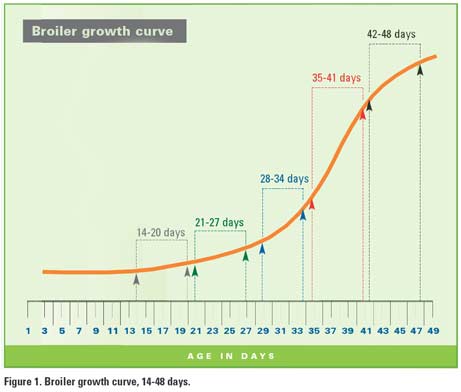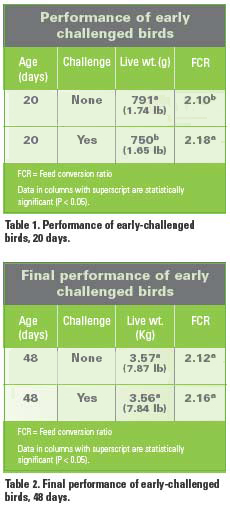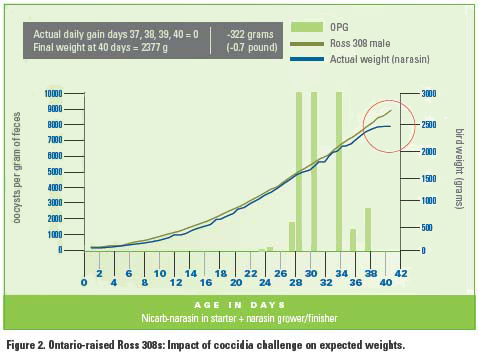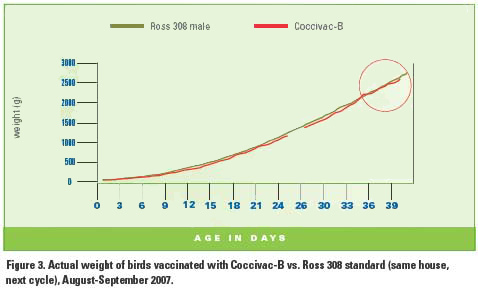
Energy Conservation
New research-driven insights on how chickens utilize
feedstuffs can help broiler producers develop new strategies
for getting the biggest bang from nutritional programs
while improving flock health.
Some of those insights were the focus
of a presentation delivered by poultry
nutritionist and researcher Dr. Robert
Teeter, a professor and nutritionist sat
Oklahoma State University, at a
recent CocciForum symposium in
Florianopolis, Brazil.
Teeter pointed out that energy obtained
from feed is used to maintain tissue
and organs, regulate body temperature,
develop immunity and support various
physical activities, including acquiring
more food to support the growth curve.
After those essential needs have been
satisfied, whatever energy that remains is
devoted to growth—or at least that's the way it's supposed to work in a
perfect world.
In reality, Teeter said, various stressors—especially disease—can significantly drain
energy reserves and rob birds of nutrients
they need to achieve optimal growth.
Stressors can also work together to have
a negative effect. "It's the combination
of stressors that have the most impact,"
he said.
Bigger impact with age
While minimizing stress as much as
possible is an important goal for broiler
producers, paying attention to the timing
of these stressors is also crucial, Teeter
said. "Early exposure to stress is, of course,
detrimental, but it has a much smaller
overall impact in terms of weight gain
or feed use," he said.
The growth curve for broilers accelerates
rapidly after about 27 days, Teeter
explained. "If the bird is hit with a
stressor before that 27-day mark, it has
time remaining to make up for any
performance it loses," he said. "But late
stressors that happen from 27 days
onward simply don't give the bird
enough time to recover lost growth."
For years Teeter and his colleagues have
been studying birds placed in high-tech
metabolic chambers that allow the
researchers to measure even subtle
changes in the birds' energy intake and
utilization. As part of that work, they
developed statistical models that reliably
predict metabolizable energy consumption
in disease-free birds.
Challenge of disease
But what about energy consumption in
birds challenged by disease?
According to Teeter, coccidiosis is one
of the most significant disease stressors
that commercial broilers face. Using tests
in his metabolic chambers, his team
contrasted healthy with infected birds in
terms of growth rate and final mass,
average daily gain (ADG), feed efficiency,
energy loss from waste excretion,
and energy use for maintaining bodily
functions.
In past work, Teeter's group confirmed
that coccidia—the parasitic organisms
that cause coccidiosis—do, indeed, have
a significant detrimental effect on all
those parameters. However, more recently
they have been digging more deeply into
how the timing of coccidia challenge
affects those measurements.
"Broilers don't grow in a strictly linear
way," Teeter reminded the audience of
veterinarians, nutritionists and production
managers. "Most of their growth takes
place after 27 days, the latter part of their
growth curve."
 Based on his
findings, he thinks the timing of the
"coccidiosis insult" makes a significant
difference in how birds utilize energy
for growth.
Based on his
findings, he thinks the timing of the
"coccidiosis insult" makes a significant
difference in how birds utilize energy
for growth.
Teeter's group performed a study in which
they assigned a group of broilers to either
an experimental or control group. The
experimental group was challenged with
three common coccidia pathogens—Eimeria tenella, Eimeria acervulina and
Eimeria maxima—and placed in the
metabolic chambers for 6 days to track
performance, body composition, metabolic
heat production, calorie expenditure and
calorie loss due to excretion. Control birds
were administered only a sterile solution.
After 6 days of collecting data in the
chamber, researchers euthanized and
necropsied the birds, ranking lesions for
severity using a standardized system.
Teeter reported that coccidia challenge
had a negative effect on performance of
all birds, with the highest lesion scores
correlating with poorest performance.
That was especially true in birds that
received a mixed challenge of at least
two species of coccidia.
More surprising, however, was that even
low lesion scores were associated with
a negative impact on performance,
especially as birds neared the end of their
growth curve.
Late coccidiosis exacts heaviest toll
To more fully assess the importance of
timing of coccidiosis challenge, Teeter's
group compared two groups of broilers—one reared in an environment that
provided a low level coccidia challenge
delivered by a live coccidiosis vaccine
(Coccivac-B); the other received
no challenge.
At 20 days of age, researchers tallied
performance numbers and necropsied
50% of the birds. The rest were reared for
the full grow-out period of 48 days while
researchers monitored their performance.
"In the group of birds necropsied at
20 days, microscopic lesion scores were
different from controls in every case,
even for this mild level of exposure,"
Teeter said.
Performance indicators such as live weight
and feed conversion also reflected some
negative effects of early cocci challenge.
However, Teeter emphasized, by 48 days
the birds had overcome that reduction in
performance—a process known as compensatory gain (Tables 1 and 2). 
"At that point the average weight of the
birds was not different—about 3.56 to
3.57 kg (7.84 to 7.87 pounds) and the
feed-conversion rate was also the same as
controls." Overall, he said that the coccidia-
challenged birds regained all of their
body mass and there was no significant
difference in feed conversion between
them and the non-challenged controls.
Measuring lost growth
Teeter also told the audience about a
useful set of mathematical modeling
tools they've developed to track how and
when birds metabolize feedstuff—a
measurement he calls "metabolizable
energy consumption."
These models assume that birds are raised
in disease-free conditions. If birds expend more energy than what's predicted by
the disease-free model, it suggests that
energy is being lost—either as additional
energy needed for maintenance (e.g.,
generating extra body heat, mounting
immune responses, increased physical
activity) or possibly from decreased
digestibility of the ration itself or
perhaps extra energy lost in excreta.
He said many of his group's findings
confirm the importance of producers
guarding against late coccidia challenge.
"When we use these tools to look at
the data we've collected," he said, "there
is a constant that seems to emerge from
the numbers—that is, for each increase
in microscopic coccidiosis score, ADG
decreases approximately 1.5% of
body weight."
That means, he said, that for a 2-kg
(4.4-pound) bird with a lesion score of 1,
the loss in ADG would be expected to be
about 30 grams (0.066 pound) per day.
For a similar size bird with a lesion score
of 2, the loss doubles to about 60 grams
(0.132 pound) per day.
These mathematical tools also show that
feed efficiency suffers in the presence
of coccidiosis.
"For each increase in visual coccidiosis
score, feed efficiency decreases approximately
0.0084% per gram (0.002 pound)
of live weight," he said, noting that nearly
half of feed eaten by birds is consumed
during the final 2 weeks before processing.
"So even with a coccidiosis score of 1, the
impact on final feed conversion is going to
be enormous."
Field experience confirms lab results

Experience gained in real-world settings
lends credence to Teeter's findings about
the potentially devastating effects of late
cocci challenge.
In one operation in Ontario, Canada, with
Ross 308 birds that were not vaccinated
against coccidiosis, very high oocyst
counts were noted around day 29, though
no symptoms of coccidiosis such as bloody
droppings were present.
When expected weights for the Ross
308 birds (as provided by the breeding
company) were plotted on a graph along
with the actual weight of the birds, a
significant loss of growth—culminating in
zero growth—was seen at day 39 onward
. Observers suspect some of
the loss in growth may have been due to
coexisting necrotic enteritis, though no
clinical evidence of that was seen.

In later flocks the Canadian producer
decided to use a live coccidiosis vaccine
(Coccivac-B) to provide early cocci
challenge. The results were dramatic.
Late weight loss was avoided due
to earlier development of immunity
(Figure 3).
Such accumulating data, Teeter says, are
powerful. "I've been awe-struck at the
tremendous impact late-stage coccidiosis
has on performance."
He sums up, "It is critical for broiler
producers to make a routine analysis of
the timing and severity of coccidiosis
challenge because, if it happens early, the
birds have time to recover. If it happens
late, toward the end of the production
cycle, there's just not enough time for
them to recover, and even minor lesions
can cause huge losses."
Spring 2008
Regresar a North American Edition (#1)

 Experience gained in real-world settings
lends credence to Teeter's findings about
the potentially devastating effects of late
cocci challenge.
Experience gained in real-world settings
lends credence to Teeter's findings about
the potentially devastating effects of late
cocci challenge.
 In later flocks the Canadian producer
decided to use a live coccidiosis vaccine
(Coccivac-B) to provide early cocci
challenge. The results were dramatic.
Late weight loss was avoided due
to earlier development of immunity
(Figure 3).
In later flocks the Canadian producer
decided to use a live coccidiosis vaccine
(Coccivac-B) to provide early cocci
challenge. The results were dramatic.
Late weight loss was avoided due
to earlier development of immunity
(Figure 3).




 Based on his
findings, he thinks the timing of the
"coccidiosis insult" makes a significant
difference in how birds utilize energy
for growth.
Based on his
findings, he thinks the timing of the
"coccidiosis insult" makes a significant
difference in how birds utilize energy
for growth.

 © 2000 - 2021. Global Ag MediaNinguna parte de este sitio puede ser reproducida sin previa autorización.
© 2000 - 2021. Global Ag MediaNinguna parte de este sitio puede ser reproducida sin previa autorización.